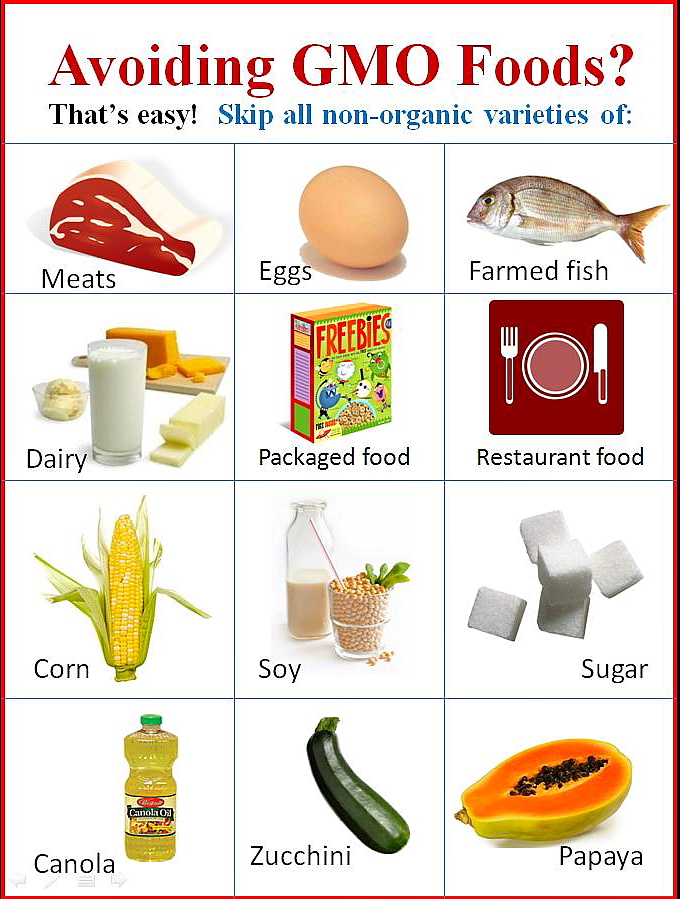It seems genetically modified food is everywhere. But it is quite easy to avoid.
The best defense is to buy food that’s labeled 100% organic. In the US and Canada, 100% organic foods cannot be GMO.
Be sure the label says 100% organic.
The simple label “organic” does not insure that it’s GMO-free. Legally, it can be labeled organic and still contain up to 30% GMO’s!
Look for products specifically labeled and certified non-GMO or GMO-free.
Trustworthy certification institutions include QAI, Oregon Tilth, and CCOF. Look for their mark of approval on the label of the product. Unfortunately the USDA standards for organic are not as reliable. A product that is certified organic by the USDA, will most likely not have the qualifications of a certification by the organizations above.
It’s important to learn which foods are most often genetically modified.
- Meat & Poultry:
Buy meats that are 100% grass-fed and grass finished. Many cattle are grass-fed, but “finished” with GMO corn. Ask your butcher for 100% organic or 100% grass-fed or pasture-fed. Most poultry is fed GMO grains. Ask for poultry that is 100% organic. - Eggs:
Eggs must be labeled 100% organic. Most “free-range”, “natural”, or “cage-free” eggs come from chickens that are fed GMO grains. The best eggs are organic, pasture raised. - Farmed Fish:
Farmed fish can now be fed GMO grains. If it is not labeled organic, you can assume it’s fed genetically modified grain. A better choice would be wild fish. - Dairy:
Look for milk, cheese, yogurt, and butter that is labeled 100% organic. If it is not, the animals have been fed GMO grains. - Packaged Food & Baked Goods:
You can fairly assume most packaged food contains genetically modified ingredients. Common ones are corn, soy, and beet sugar or their derivatives. A better choice is to avoid the packaged food section. Buy fresh foods and cook from scratch. - Restaurant Food:
Most restaurants buy from large national suppliers that distribute GMO ingredients. The most common GMO ingredients in restaurants are beet sugar, corn, soy, and canola. Often the oils are genetically modified. If you ask the waiter a specific question about oils and sugar, it can usually be answered by a trip to the kitchen. A restaurant offering organic meat, poultry, dairy and eggs will usually state it on the menu. Otherwise, you can assume they are fed GMO grains. One solution in restaurants is to order vegan, to avoid GMO-fed meat, poultry and eggs. - Corn:
The vast majority of corn sold in the USA is genetically modified. There are thousands of derivatives of corn to recognize, such as high fructose corn syrup, dextrose, cornstarch, etc. Even local corn can be GMO. Look for 100% organic corn, popcorn, or corn chips. - Soy:
The vast majority of soy sold in the USA is genetically modified. There are thousands of soy derivatives to be aware of, such as tofu, soy milk, soy cheese, vegetable protein, soy sauce. If it’s not labeled 100% organic, then it’s GMO. - Sugar:
Sugar from GMO beets is labeled simply as “sugar”. So when you see “sugar”, you can’t tell if it is GMO or not. However beet sugar is cheaper than cane sugar. Most manufacturers using “cane sugar” will label it as such, because it is considered more desirable. For this reason, when you see the ingredient “sugar” on a label, you can assume it is probably GMO beet sugar. - Canola:
Canola oil, or rapeseed oil, is one of the most common GMO ingredients. Look for 100% organic on the label. - Zucchini:
Zucchini that is not labeled organic is most likely GMO. Fortunately, it is relatively easy to find organic zucchini – or grow it in your garden! It grows as fast as a weed in mine. - Papaya:
All Hawaiian papaya is genetically modified. If papaya is not labeled 100% organic, you can assume it is GMO.
Other Tips:
Learn fruit and vegetable label codes:
- A 5-digit number beginning with a 9 indicates it is organic.
- A 4-digit number indicates the food is conventionally produced, or not organic.
- A 5-digit number beginning with an 8, means it is GMO. However, GMO food may not have a PLU identifying it as such, because PLU labeling is optional.
Shop locally.
If you shop at farmer’s markets, you’re more likely to find non-GMO food. Most GMO food comes from large, industrial farms and is sold nationally.
Buy whole foods instead of prepared foods, and cook from scratch.Better yet, grow your own. Enjoy the flavor and higher nutrition in freshly harvested food!










